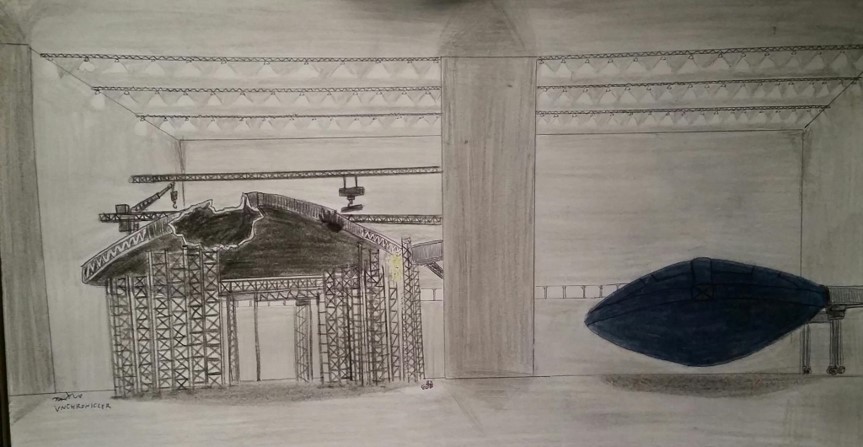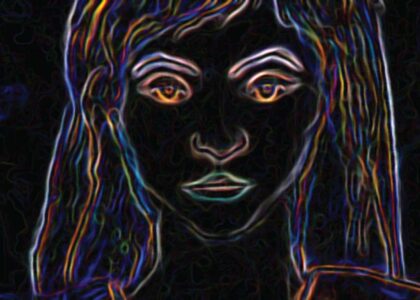Originally posted on August 6, 2017, this article is restored from a previous version of my website. Spelling, punctuation, and grammatical errors have been corrected.
INTRODUCTION
YouTube and Facebook have allowed me to connect with many different people, including other YouTube Creators, such as Denny Hunt and DeEtte. These YouTube Creators and other folks like Jeff Rense and Frank Chille, have inspired me with their persistent focus and consistency. They have helped me to connect with people like Tony Rodrigues, the late William Tompkins, and others. To them and the many others working behind the scenes that have provided a wealth of information – you know who you are – I say thank you. I urge everyone to continue seeking, asking questions, and being excellent in all you do.
I’ve had a handful of communications with Tony, where he graciously acquired the permission from artofkaan.com to post and share the sets of drawings you’re about to see. Through the process of writing this article, Tony answered many of my questions and set me straight on my misinterpretations. The content you’re about to read is the result of exchanging drafts and revisions, until I got Tony’s final approval. I wanted to avoid incorrectly characterizing the events he shared with me. I’m glad I met Tony. I was simply inspired to explore his story and am happy he’s allowing me to share some of it with you.
As an aside, I especially enjoyed learning about Tony’s perspective of his ship’s artificial gravity problems. You can read about all that in the last sections. While I’m sure this article is not 100% complete; because Tony is still remembering and recording the events of his twenty years with the Dark Fleet, I’ve done my best to summarize the smattering of events he shared with me.
Tony, thank you for trusting me and for being a friend. If there is anything else you would like to change or modify, please contact me; and, I’ll make edits, as needed. I wish you all the best on your book project.
Everyone else, I hope you enjoy reading this as much as I enjoyed working with Tony to write it.
Save 20% on your firsrt order!
WHY WAS TONY ABDUCTED?
In 1981, Tony Rodrigues was nine years old and attending Talented and Gifted (T.A.G.) Classes in school. One day, he had an encounter with another boy. The boy had told Tony that his father was Illuminati. Not knowing what that was, Tony picked on the boy, earning his contempt.
Later that year, the school held a science fair. The boy pointed-out Tony to his father, who was acting as one of the science fair judges. Soon after, Tony was abducted and made a slave in the twenty-and-back service to a secret space program. During that time, he was traded from program to program.
Ultimately, Tony wound up living on the planetoid Ceres; working for a German breakaway group; and assigned to a Dark Fleet cargo ship. The Dark Fleet is the most advanced of all secret space programs. It was spawned from Nazi Germany’s association with reptilians. Unlike typical slavery, where freedom can’t be won outside of death, Tony’s involuntary indentured servitude expired after twenty years.
Tony’s memory of the twenty years was wiped. His body was age-regressed and returned to the location and point in time where they had first abducted him. After being returned to Earth at the biological age of nine, another twenty years passed; and, Tony’s memories of his slavery began to creep in.
As they returned, he wrote them down. He made some drawings and engaged the help of an artist to depict the beings and locations from his memories. Over the past few years, and in light of Corey Goode’s mentioning the Dark Fleet in his interviews with David Wilcock, Tony decided to publicly share aspects of his life working as a slave under the oppressive Dark Fleet.
Tony is married with a family, living a normal American middle-class life. He hopes someday to publish a book that describes his experiences. This web page represents a summary of some of the experiences that Tony shared with me.
ET RACES ON CERES COLONY BASE:

by artofkaan.com. This is a depiction of one of the two races that lived on Ceres colony with the Germans. They’re seven feet tall; feature different hair colors, which is always long and straight. The second race was much bigger, had wider hips, were nine feet tall, had a bigger head.
A REPTILIAN ET CO-WORKER:

This is a reptile extraterrestrial that Tony Rodrigues spent hours with when he was on the Draco trapezoid moon base. This guy had a sense of humor and told Tony that he would return to his planet every day after work.
GRAY ET:

An extraterrestrial gray that Tony Rodrigues woke up and saw, your typical grey alien. Tony says he’s not sure about the accuracy of the eyes.
MANTIS ET ON MARS:

This is an extraterrestrial Mantis being that Tony met on Mars. He thinks it scanned him. The body doesn’t look quite right. The artist created this drawing in about 20 minutes. He was very fast, so Tony didn’t really critique the bug’s rear end and other details. Although, he remembers it being skinny and estimates its weight on Earth to be about 150-lbs. It was big — not a heavy thing.
SPIDER ET:

This is the bug that Tony and others fought while they were on the Lunar base. Tony remarks that this is an ugly bastard. He showed Kaan’s depiction of these bugs to Randy Kramer, who claims to have served twenty years in the United States Marine Corps with the Secret Space Program fighting them and performing other tasks on Mars and in and around our Solar System. Randy confirmed this drawing matches his memory of them.
BLACK REPTILIANS:

Extraterrestrial Black Reptilians on a desert base with a double disc ship. This image depicts an away mission at a desert base of a planet unknown to Tony. They were trading with tall shiny-black reptiles.
CERES COLONY

The Ceres Colony Base at Ahuna Mons is circled in red. Ceres is a dwarf planet 587 miles in diameter. It is the largest object in the asteroid belt, which lies between the orbits of Mars and Jupiter. Ceres Colony consists of several underground town-sized areas. When the Germans arrived, they discovered a pre-existing infrastructure, complete with hangar doors and towns built into the craters.
Tony doesn’t know when the Germans arrived. He observed that the structures were old and installed by men. He estimates they had to have been constructed at least forty to sixty years before he arrived; as, many of the ceilings were made of a corrugated metal that were rusting. Heavy construction was common the whole time he was there. The brothel, mentioned later, was remodeled twice in less than two years.
The military hangar and base where Tony lived and deployed from was located near a large cryovolcano, Ahuna Mons (circled in red). The base’s entrance is located in a large crater adjacent to Ahuna Mons.
FLIGHT PATH TO CERES BASE AT AHUNA MONS:

The Bright spots on Ceres are deposits of magnesium and salts from a geyser that erupt every six to nine years. (Occator Crater).

These maps depict the flight path Tony took as the geyser was erupting. He estimates the time of eruption to be sometime around 1999-2000.
CERES BASE HANGAR DOORS:

These are the doors leading to into a Ceres Colony hangar.

Tony is aware of several hangars on the planet, but he never went to the others. He is unaware of their locations.
DAMAGED TRIANGLE CRAFT AT CERES BASE:

Tony saw the badly damaged belly of this ship being repaired in the Hangar on Ceres Colony. Artist: Douglas Quaid (Total Recall movie’s main protagonist?)
He notices it wasn’t using its own antigravity system. It had no power. This is unusual”, Tony says, “because once the ship’s antigrav is activated, it’s never deactivated”. Tony’s cargo ship, the Max Von Laue (MVL), was hard-capped at ten meters from any surface before the ship’s computer would halt movement. This triangle ship was dead— its power shut off. He asked someone how bad the damage would need to be for the power to be cut off; and, their answer was, “Over seventy percent. It’d be a miracle if anyone survived.”
CERES BASE HANGAR INTERIOR:

Located at the very end of the complex, just off of the hangar bay. Tony would walk to this cavern on paydays, rather than take a train. The air here was thin, due to its proximity to the hangar doors.
CERES BASE UNDERGROUND TRAIN STATION:

A train station for an underground rail system on Ceres Colony. Bahn is the German word for train.
FOYER OF CERES BASE BROTHEL:

This is the foyer of a brothel on Ceres Colony. On display is a low-gravity piece of art. Water and balls of fire intermingled in a micro-gravity display. As the gravity increased, the balls of fire and water would clear and then start another cycle. Tony says it was amazing to watch.
ROOM OF CERES BASE BROTHEL:

This is inside a room of a brothel on Ceres Colony. The bed is a low-gravity bed with five settings from zero to one G. The brothel underwent refurbishing twice during Tony’s twenty-and-back.
THE MAX VON LAUE

These are interior views of Tony’s Dark Fleet ‘Cargo’ ship, The MVL (Max Von Laue), where Tony served as a slave. He remarks that gravity reduces when descending the ladder. This is an area of the ship that Tony enjoyed traversing. Those working below would get annoyed with Tony for lingering here. Sometimes, his lingering would make him late at his duty station.

The ship ran a tight operation that focused heavily on productivity. Everything, all activities, on board is recorded. Productivity is constantly measured and if you fall off your mark, the recordings are examined to determine a cause. There was a reward system; and, Tony endeavored to achieve these rewards. One award allowed him to view their approach to Ceres Colony Base from the bridge.
ABOUT THE MAX VON LAUE:

Tony’s Pencil Drawings of The MVL (Max Von Laue) CARGO SHIP
The Max Von Laue Dimensions
The MVL cargo ship is 1,000’ long and 600’ wide. Tony says he never saw the whole ship; but he was able to estimate the dimensions whilst on the ground at Diego Garcia, where he disembarked and walked around it. He used Google Earth and his memory of the ship’s position, relative to parking lots and structures, to determine its size.
Interior Cargo Bays
The ship has five cargo bays. Tony operated two bays on the port side. Two more bays are located on the starboard side; and, one large cargo bay is located the middle, which has a door that opens aft. Storage rooms were located underneath, which were rarely used because they were too difficult to access.
Battle Groups at Trapezium Cluster
Tony remembers there was a battle-group stationed near the Trapezium Cluster (a small star cluster) in the Orion Nebula. It may have been a Draco battle group. It looks much different up close, only light-red colors and the stars illuminate a huge cloud that completely filled his field of vision. This place near the Trapezium Cluster was just a coordinate in space, where a battle-group would meet. Tony’s ship would deposit cargo there in dead space and leave it for pickup. Tony remarked seeing thousands of ships. It was absolutely huge.
Prestige of Service Aboard Triangle Craft
The command was proud to be present in the Trapezium Cluster. He also wrote about how everyone viewed duty on the triangle-shaped ships. The officers wanted to be transferred to one, because it was the best post. It paid more and “…everything and had a sort of higher rank.” By this, I assume there was more prestige associated with duty aboard those ships. I wonder why? Given the condition of the triangle ship Tony saw at Ceres, is regular combat associated with its duty? Are those assigned to these ships aspiring to emulate the Draco, reptilians, or others; or, is there some other explanation?
The Bridge of the Max Von Laue

This is what some of the crew wore on the bridge. This drawing is a little different from what he remembers. The notable points are that everyone, except the captain, wore virtual-reality-looking goggles and worked with thin curved screens in front of them. A main screen on the wall permitted the captain to display anything he wanted. Tony had only ever been on the bridge once. While there, he heard the radio call sign for Ceres Base, “Pyramid Base”.
TONY’S CARGO BAY WORKSTATION:

This is Tony’s workstation. There were many of these on the MVL; although, some on other decks looked different. Common to all of them: logins were required. Basically, it was a touch screen housed in a steel frame about four-feet tall. Once logged on, a menu appeared, which provided an industrial-looking interface where Tony entered cargo weights and dimensions. The workstation would print out reports on topics such as how and where cargo should be stacked; available space; etc.
Cargo Area Function
Tony’s two cargo bays were used to handle and store smaller sized cargo – most of the material that his bay could manage measured about the size of a chest or a fifty-five gallon drum. Anything bigger than that required a Tipping Report. Larger cargo was handled by the main cargo crew in the center, which opened at the aft of the ship. Tony recalls spending hundreds of hours entering data at this workstation. At times, he would lean on it and nod off.
Interior Appearance
Everything in the lower decks is coated with an off-white epoxy-looking substance. The construction and design of the lower four decks, where Tony worked, were Spartan; whereas the upper decks were plusher – decorated with shades of gray paneling, red and black carpet. Describing what it felt like moving from the upper decks to the lower decks, Tony says it’s analogous to transiting from an airliner’s interior to an industrial area.
Gravity Plating Hardware
At his workstation, the floor on which he stood was a thick steel grating of squares, which was also coated with an off-white epoxy. A few inches below the grate, he could see several layers of things. He knew the gravity plating was just below. Ninety percent of the gravity device was obscured with such things as a metal-looking mesh and wires that were enclosed and well-hidden in what appeared to be conduit. At certain spots under the grate, Tony could see the interconnections of octagonal-shaped, mason-jar sized tubes. He was able to see that these arrays of octagonal tubes connected to each other like Lego bricks and that each gravity plate, or arrays of tubes, was about one square meter in size and about ten inches deep.
ARTIFICIAL GRAVITY PROBLEMS:
In an area near the rear starboard side of the Main Cargo Bay, for some unknown reason, entire stacks of boxes and other cargo would scoot a foot or so and become crushed, breaking the contents. The crew attempted multiple solutions to lock it down – to better secure the cargo; but, stacks of things kept getting crushed and moved. Their attempts to resolve the problem involved strapping-down the material; but, no matter what they did, it still moved. The crew also tried painting the floor with a stickier epoxy and applying grip tape; but, none of that solved the problem.
Design Flaw
The root cause of the shifting-cargo problem was revealed to be a design flaw in the ship’s propulsion or drive system. Whenever the ship engaged certain maneuvers, a gravity field disruption was created in that part of the main cargo bay. As a work-around to the design flaw, cargo stacking guidelines and procedures were created for that area. For basic flight, the area was used. For flights involving various maneuvers, it was not used.
Tony’s book: Ceres Colony Cavalier: A True Account Of One Man’s Twenty Year Abduction


